What follows is a post by my friend and fellow mom, Kimberly Tatum. In observance of World Clubfoot Day, she recounts her experience when she and her husband realized their baby would be born with clubfoot and the subsequent treatment that would follow. On a personal note, her calming smile helped to keep me sane (and a little less scared) throughout the deliveries for both of my children. I don’t know how I would have handled those experiences without her, and I’m glad I’ll never have to know. I’m so lucky to call this great mother my friend. —Kristen
June 3rd is World Clubfoot Day. Clubfoot affects approximately 1 in every 750 births and is twice as common in males as in females. With proper treatment, clubfoot is a very treatable condition, but the process can be overwhelming especially for parents who are not prepared for what is to come.
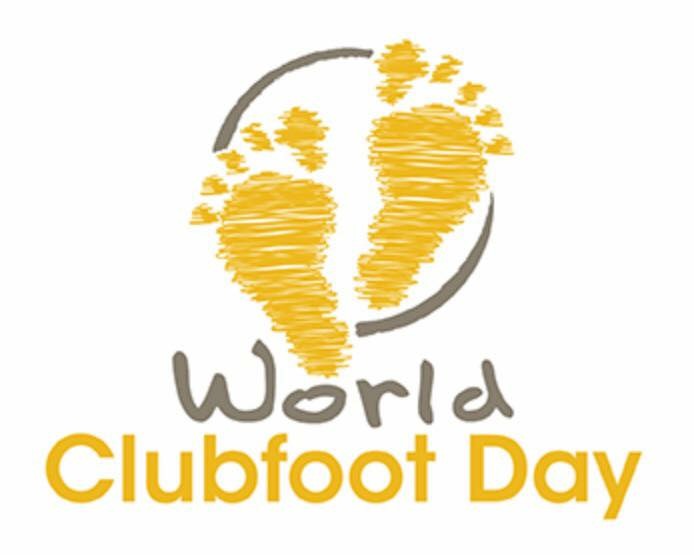
Our clubfoot journey began on December 27, 2013. I was 26 weeks pregnant, and we were scheduled for a routine visit with Maternal Fetal Medicine due to my gestational diabetes. We had a normal anatomy scan at 20 weeks, so we were really thinking this would be a quick visit to review my blood sugar numbers. The ultrasound tech did the ultrasound, and then the doctor came into the room. He did his part of the ultrasound, and as he reviewed each part of the baby he said everything looked great. However, I noticed he was spending a really long time looking at the legs and feet. Even with the thought that he was very focused on the baby’s feet, I NEVER imagined that there would be anything wrong. Then he said, “Kim, the ultrasound tech thought the baby may have a clubfoot, and I agree with her. Based on the baby’s position it is hard to tell for sure right now.” I don’t remember much of what he said after that. There was talk of the baby looking perfect otherwise, and that he was pretty confident if we were dealing with a clubfoot that it was isolated. There was talk of bracing the foot to fix it. Really, the rest of the appointment was a blur. I can remember getting off the table and walking out of the office and just feeling numb. Even after being a labor and delivery nurse for almost 8 years at that point, I knew absolutely nothing about clubfoot or the treatment for it.
I spent the next couple of weeks doing lots of research. Yes, I Googled it. And yes, I know that was the wrong thing to do. I did learn that there were two approaches to treating clubfoot. The current recommended practice involves a series of casts and then braces for years, much different from the older surgical approach to treatment. The next couple of months I had several more ultrasounds. Some confirmed the clubfoot, and others gave us hope that it might just be positional. But finally around the beginning of February I was at peace with whatever we faced. We were beyond excited to welcome our sweet baby!
On March 17th, our little shamrock BOY was born screaming and healthy. It was several minutes after he was born before I even thought about his foot. The transition nurse confirmed that he indeed had a left clubfoot. I worried so much leading up to the delivery that the clubfoot would dampen the excitement of the delivery. But really, it wasn’t even a thought on the radar. We had a healthy baby, and we were in love!
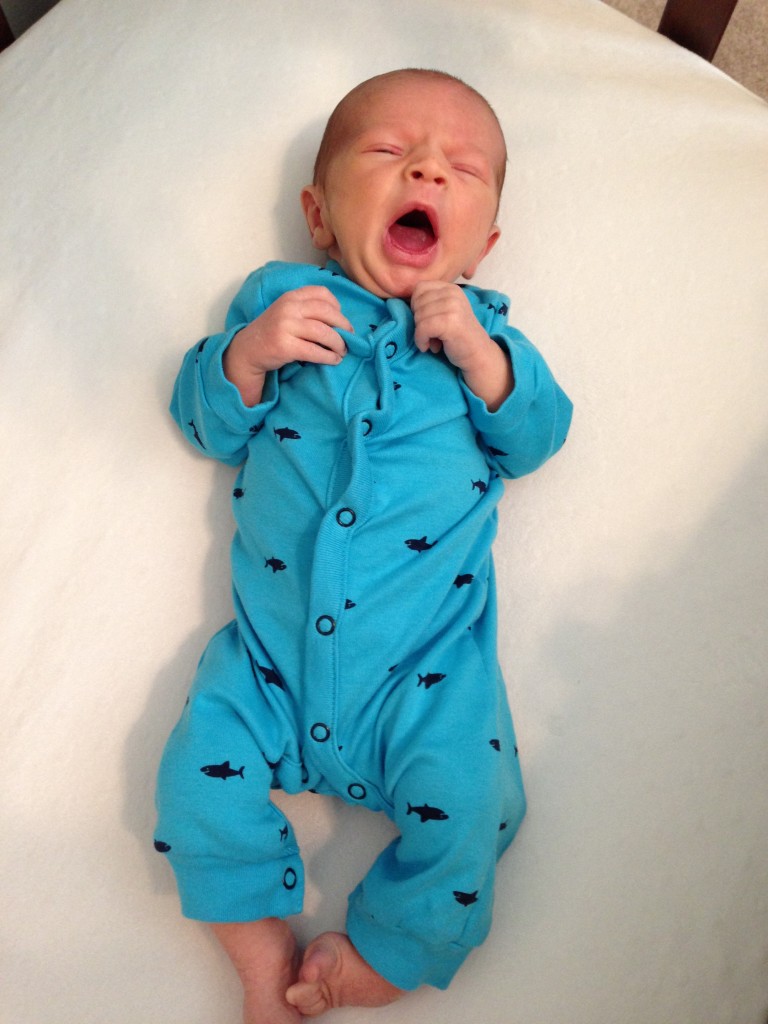

When Collin was 2 weeks old we had our first visit with the orthopedic surgeon. He explained the treatment plan. Basically the baby would have to undergo a series of castings, changed weekly, for 6-8 weeks. After that, Collin would need a very minor procedure on his foot and then would wear his last cast for three weeks. After the casting phase was complete, he would be in a brace with a bar between his feet for 3 months, 23 hours per day. Finally, the last stage was sleeping in the brace until he is 4 years old at nap and nighttime.
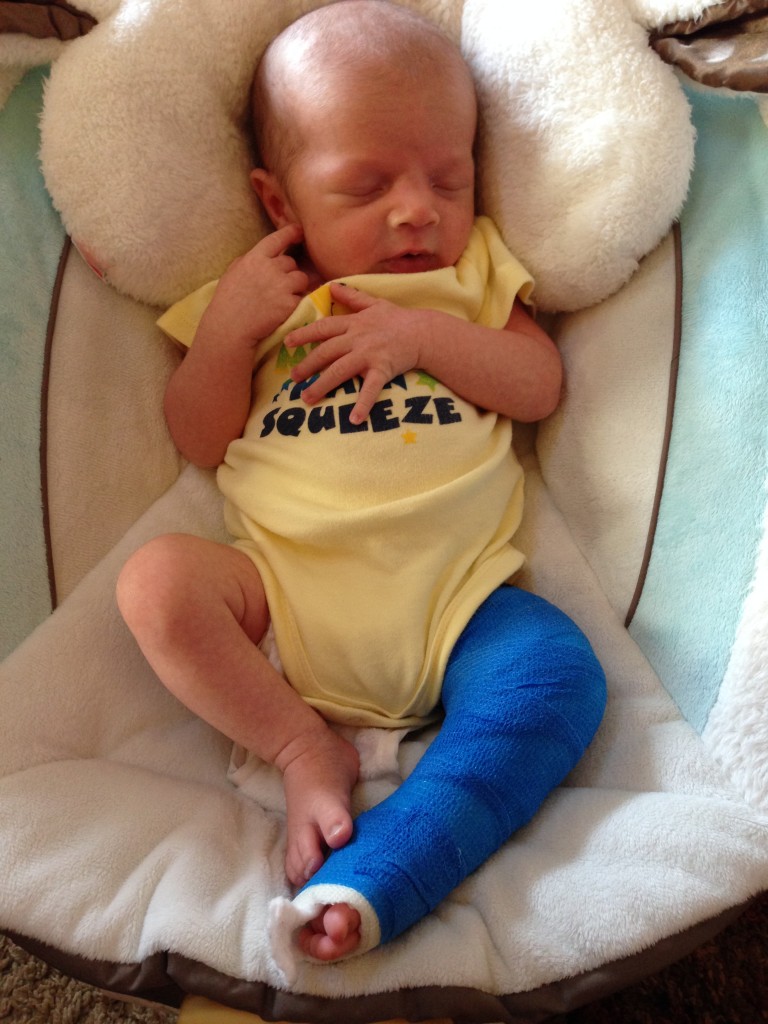

At 3 weeks old we began the process, as Collin got his first cast. It was hard to watch the doctor turn his foot towards normal and then apply a cast to hold his foot there, but he tolerated the casting process like a champ and soon our weekly casting changes became routine. We felt like part of the family at the doctor’s office because we were there so much! He required the full 8 weeks of casting, and then at the end of May he went in for the minor outpatient procedure. He had no issues after the surgery, and mid-June he received his brace, which is often referred to in the clubfoot community as Boots and Bar. This presented a new challenge for us: it was awkward for us to hold him with a bar between his legs and after a few weeks in the brace, he started figuring out how to move his legs…and that the brace could be used as a tiny baby fighting device!
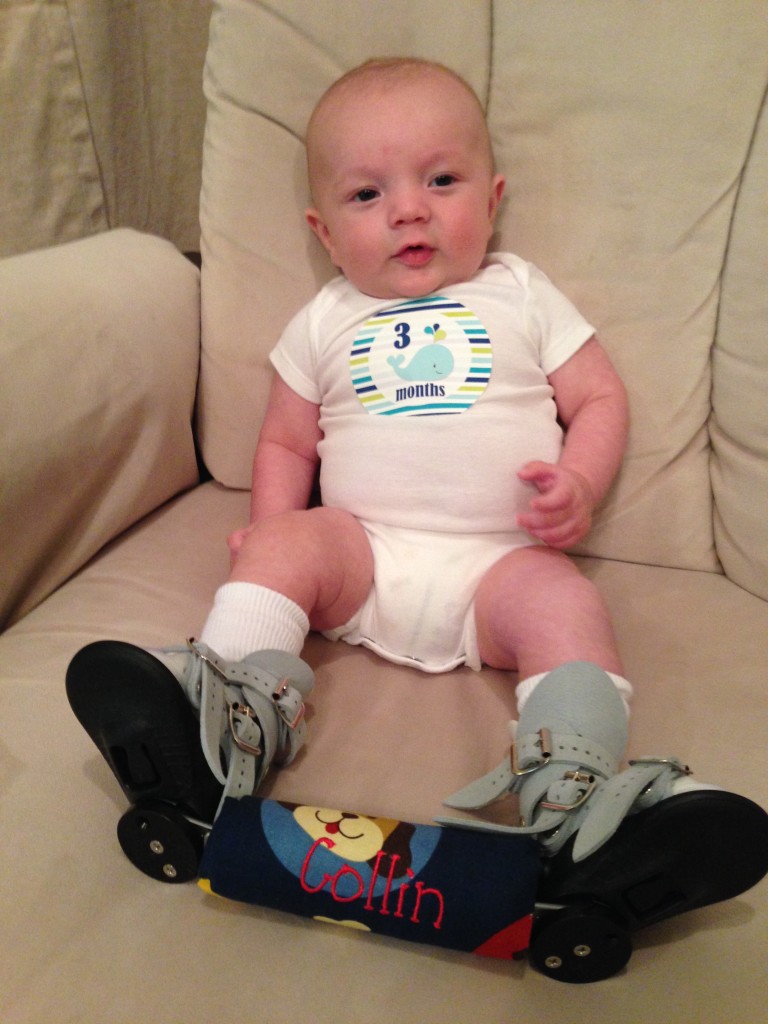



His leg was super sensitive after being in the cast for so long, but after the first few days he tolerated the 23-hour days of brace wear very well. His hour out of the brace was a few minutes of tummy time and bath time. Before we knew it, it was September and he was released to only wearing the brace at night and naptime. And we celebrated! We had made it through the hardest phase of our journey!!! Collin currently wears his brace at night (and WHEN he naps! HA!!) and will do so until he is 4 years old. It is part of his bedtime routine, and he loves to play with his bar until it is time to connect it to his shoes.


Looking back over the past year seems like a blur. Really, it has gone by so incredibly fast and it seems so fresh that we were sitting in the orthopedic surgeon’s waiting room waiting for that very first consultation appointment. While we still have a couple years of treatment ahead of us, I believe the remainder of his treatment will be routine and will certainly bring fewer tears…both for Mommy and Collin. I hope that by sharing our story, that I can raise awareness about clubfoot. And that I can give a mom or dad who just got the diagnosis the realization that despite the first six months of treatment being really hard, that things will be okay.




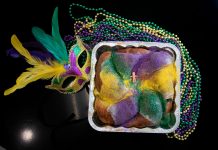







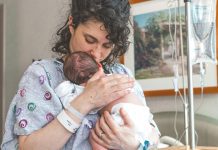

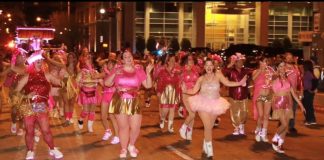




Great story!!
Ponseti Method of Clubfoot Treatment is the most widely practiced method for initial treatment of infants born with clubfeet.
I really appreciate your blog. Clubfoot is a common birth defect that can make walking difficult. With early treatment, most children born with clubfoot are able to lead normal lives. Although clubfoot is painless in babies, treatment should begin immediately, as delaying therapy can cause significant problems as the child grows. We offer 4 models of AFOs to meet your needs. We believe your precious baby’s feet deserve the best and thus we leverage our knowledge and expertise to design clubfoot devices, AFOs, and similar solutions that are in compliance with the Ponseti Method. We design and manufacture custom fit solutions for clubfoot treatment right here in Iowa. Thanks for sharing this blog.
Wonderful encouraging story. Thank you for sharing. Thomas, where are you located and what is the name of your company?
Hi
Amazing post. Thank you so much for sharing your story.